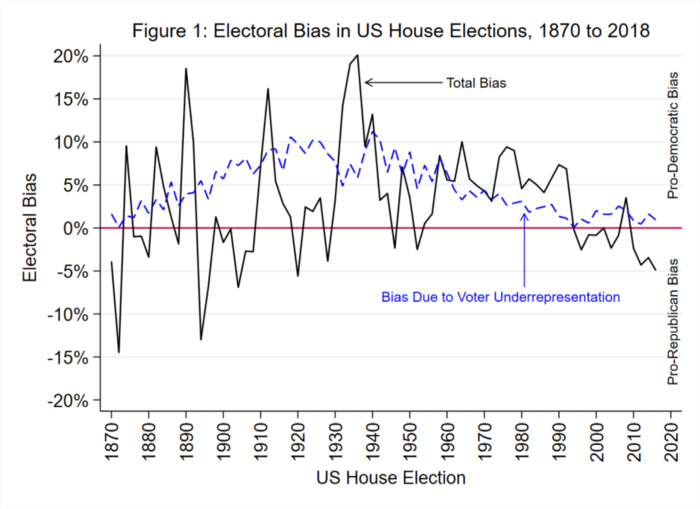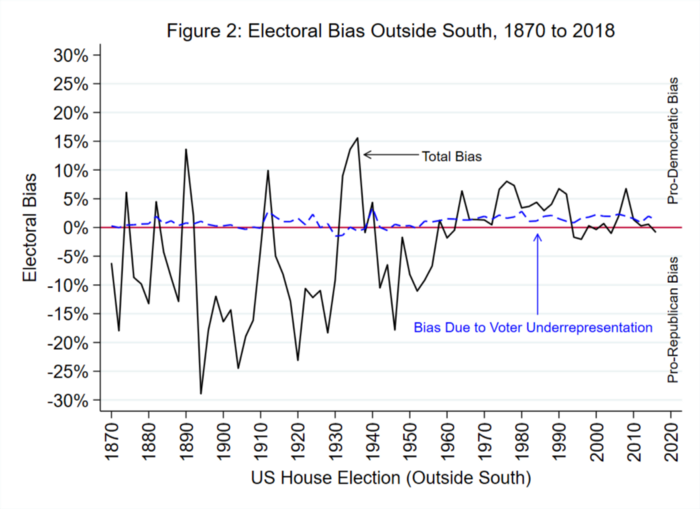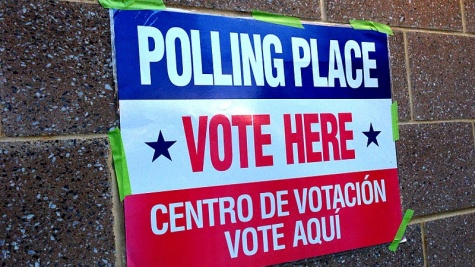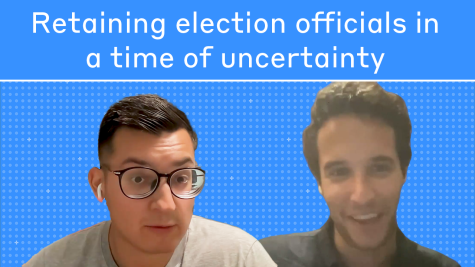Can Voter Suppression Increase Electoral Bias?
Voter suppression has become an increasing concern among proponents of voting rights, especially as federal courts have shown through Shelby County v. Holder (2013) and subsequent cases that they will adopt a more hands-off stance on questionable actions by state governments. In reaction to these changes, political scientists and other scholars have published considerable amounts of research demonstrating the rising threat of voter suppression in the United States.
I approach this issue from an angle of electoral bias. With funding support from the MIT Election Data Science Lab (MEDSL) as well as the American Political Science Association’s Centennial Center (APSA), my research looks at the relationship between voter suppression and electoral bias. Specifically, I am asking the question, can voter suppression increase electoral bias in single-member district electoral systems?
Does the way we run elections in the United States make voter suppression a more potent strategy than in other countries and therefore a greater danger to the future of American democracy? My findings show that this is exactly the danger we face.
The Question
By examining electoral systems, I am stepping back and trying to understand voter suppression in the US within a wider framework. An electoral system is the overarching way a country runs its elections. There are many types of electoral systems, but the two most common use either single-member districts (SMD) or proportional representation (PR). In SMD, the country (such as the US) is divided into districts, and each district elects one officeholder. In PR, the proportion of seats each party wins in a legislature is consistent with the overall percent votes they receive.
Electoral bias occurs when a political party systematically wins a higher percent of elected positions in comparison to the percent vote it received. A well-established cause of electoral bias in SMD systems (and one that political scientists discuss at length) is gerrymandering, or when legislative district lines are drawn in ways that increase the number of seats the governing party wins in comparison to the votes it receives. My argument is that gerrymandering is only one of many possible causes of electoral bias. My first step towards establishing this has been to demonstrate that electoral bias has had a long history in American politics — it has existed long before the current wave of extreme gerrymandering orchestrated by the Republican Party. Indeed, in my analysis of elections to the US House of Representatives, I have shown that electoral bias was much greater in the middle of the twentieth century than today, and I have also demonstrated that gerrymandering alone could not have caused most of the electoral bias in those elections.
So, what else besides gerrymandering might cause electoral bias in SMD systems? One possibility is voter suppression. To make a comparison, consider that in a PR system, when 1% fewer supporters of a particular party are kept from getting to the polls, that party is likely to win approximately 1% fewer seats in the legislature. But in SMD systems, a 1% decrease in voter turnout by the supporters of a party can instead cause a much larger number of districts to flip to another party and thereby cause a much greater seat loss. Effectively, this implies a “double whammy” for those being kept from the polls. That section of the electorate ends up losing their immediate influence on the election, and if the strategy of keeping them from the polls is effective enough, it can target districts in a way that causes a large number of districts to flip to the other party like dominoes.
Why is this the case? One reason is that in SMD systems, the number of seats a party wins is only crudely related to the percent of votes it receives. Even small shifts in the vote can cause significant changes in how many elected positions each party wins, depending on how the geographic distribution of the vote shift is related to how district lines are drawn. If the shift happens in many districts where the elections are already close, or if the shift is highly concentrated in one region, then many districts can flip even when the vote shift is not that large. Voter suppression can cause exactly these types of disproportionate shifts.
A second reason, to make matters even worse, is that SMD is easier to manipulate than PR. While gerrymandering is very easy to orchestrate within SMD systems, it is much harder if not impossible in PR systems, for example. (This is because there are few, if any, district lines in PR systems and since these districts elect multiple officeholders in a proportional manner, the impact of manipulating the district lines tends to be muted.) Similarly, when it comes to voter suppression, the playbook is surprisingly easy to pull off in SMD: find districts that your opponent is likely to win, especially by a small margin, and then invent an excuse to make voting harder for your opponent’s supporters in those districts. For example, if your opponent wins support in urban areas, reduce the number of polling places so that it becomes much harder to vote in urban than rural areas. If your opponent is supported by particular economic or ethnic groups who live in concentrated geographic areas, find ways to target those groups and get them thrown off the voter rolls.
In other words, the way the United States runs elections makes voter suppression a much more potent and effective strategy, which in turn poses considerable danger to the democratic process. The question that followed from this, and which I then set about examining was whether this threat to American democracy as perpetuated by voter suppression has already influenced American politics.
The Evidence
Since I am trying to get a larger picture of how our SMD electoral system amplifies the impact of voter suppression in the US, I have taken a more historical view and examined elections over a long period. Because of this approach, and like in all scientific research, I still needed to get around a few hurdles in the process. The first was getting the data. Most of the US House of Representatives election data that extended back into the nineteenth century had significant missing information and other problems that weakened the data. With grant support from MEDSL and APSA, I therefore set about collecting comprehensive district-level results for all candidates who ran in US House of Representative elections from 1840 to 1974. This data will now be housed at the MEDSL website, where anyone can download it for use in their research. Combined with the 1976 to 2018 data that was already made available by MEDSL, this expanded dataset will be the most extensive US House election data that is publicly available in electronic form.
The second hurdle I needed to overcome was to simplify the question enough so that I could test it with the data that was available. To do so, I expanded the question slightly. Instead of just voter suppression, I measured all forms of voter underrepresentation, which includes malapportionment and low voter turnout. I then used a new measure of electoral bias that I have developed, called “DPIx” (or “directional proportionality index”) to test the theory. DPIx can be used in a number of ways, but in this case, I was specifically measuring bias toward the Democratic Party vis-à-vis the Republican Party. I did so in two ways: the first way looked at the entire bias, while the second looked at the bias caused entirely by voter underrepresentation.
As the graph below shows, since 2012 there has been around a 5% bias in US House elections favoring the Republican Party, a finding that is consistent with other existing research showing that gerrymandering has been aiding the Republican Party. But the story doesn’t end there — the graph below also shows that there was significant electoral bias over the entire 150-year period that I have collected data for, and that in the past electoral bias often benefitted the Democratic Party. Follow the blue line in the graph: it shows the electoral bias due to voter underrepresentation, which started to rise around 1870, became substantial around the 1930s, and then slowly declined starting around 1960. That bias does not completely disappear until the 1990s. While the overall DPIx measurement jumps around considerably during this period — a common occurrence in SMD systems — the electoral bias caused by voter underrepresentation emerges as being steady, clear, and consistently in favor of the Democratic Party.
Why did this bias due to voter underrepresentation rise and then decline? Well, consider the fact that this time frame fits almost perfectly the history of Jim Crow in the former Confederate states. One of the key characteristics of Jim Crow was extreme voter suppression, especially towards African Americans, who overwhelmingly supported the Republican Party through much of this period. The blue line begins to rise just as violence is beginning in the American South, reaches its peak as Jim Crow becomes completely institutionalized, and then begins its decline as the Civil Rights Movement becomes highly active, and especially after the passing of the Civil Rights Act of 1964.
So how do we know that the rise and fall of the blue line was caused by Jim Crow? Well, an easy way to test this is to examine the exact same data but exclude states that had been in the former Confederacy. This is shown in the graph below. This graph demonstrates that once we remove the Jim Crow states, the electoral bias caused by voter underrepresentation (and therefore voter suppression), as demonstrated by the blue line, all but disappeared.
Conclusion
The evidence that I found and the analysis that I have presented demonstrates clearly that voter suppression can cause significant electoral bias and that it is therefore a threat to American democracy very much like gerrymandering. The evidence is also consistent with the argument that electoral bias jumped in the Republican’s favor in 2012, right after state governments controlled by the Republican Party began taking extreme measures to gerrymander legislative districts. But my findings further suggest that there are likely a range of ways in which electoral bias can be caused in SMD systems, including through voter suppression.
It is my hope that this work adds to the significant amount of research being conducted on voter suppression and that it highlights why those efforts are so important. What my findings suggest is that well-targeted suppression that may seem minor on the surface can end up having a significant impact. Some people cannot vote because they lack the proper identification. Others are banned from voting because they had once been arrested. Yet others give up on voting altogether because the number of polling locations have been reduced, and they find the process too tedious and the wait too long. Under the right circumstances, therefore, it is not hard to imagine how this could trigger the flipping of districts in ways that fundamentally change the power dynamics within the American government.






